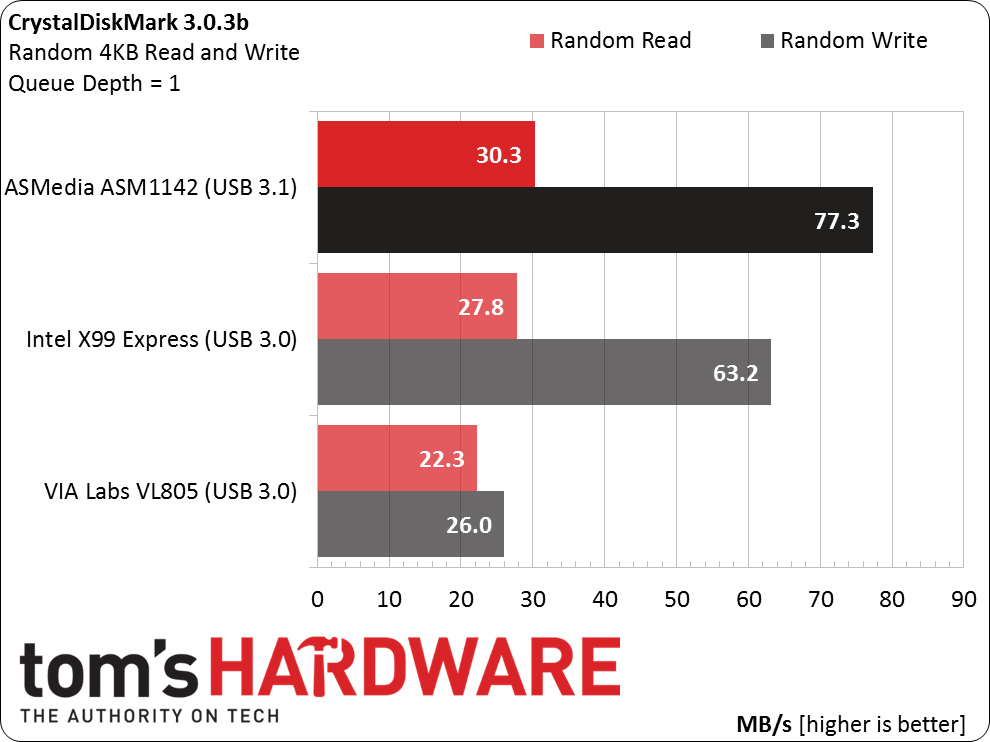USB 3.1 Tested: Performance On MSI's X99A Gaming 9 ACK
We got our hands on the first USB 3.1-capable motherboard, MSI's X99A Gaming 9 ACK, and ASMedia's ASM1352R-equipped developer board for some early benchmarks with two striped SSDs and an ultra-fast thumb drive.
Results: USB 3.1 Vs. USB 3.0
CrystalDiskMark
We’ll start with synthetics, since that was what everyone at CES saw.
USB 3.1 enables sequential reads in excess of 700MB/s, and we’re told that a couple of Samsung 840 Pros crest 800MB/s plugged in to the same developer board. Intel’s X99 chipset manages 423MB/s, while VIA’s PCI Express-connected controller can’t even muster 300MB/s.
Write performance isn’t far behind (though we’ll see real-world sequential writes fall off faster). ASMedia’s USB 3.1 controller continues to exceed 700MB/s. Intel’s PCH-based logic actually accelerates, hitting 426MB/ and the VIA VL805 tops out at 257MB/s.
Random I/O isn’t nearly as impressive. But that’s what we’d expect from USB (or any other interface, for that matter). You’ll see reads approaching 7400 IOPS in 4KB reads at a queue depth of one from USB 3.1, while Intel’s controller yields over 5400 IOPS. This is one discipline where VIA comes out ahead of Intel; the VL805 posts nearly 6800 IOPS.
Real-World File Copy
Synthetic metrics work well if you want to isolate a specific performance attribute or test a peak using controlled data. But they rarely correlate with real-world results. That’s why we’re also including a real-world file copy test that includes 91 files in 27 folders totaling 36.7GB. Clearly, these transfers are going to be sequential in nature.
Reading data from the USB-attached RAID array and writing to a 40GB RAM disk on our PC yields much higher performance than writing to the external SSDs. ASMedia’s USB 3.1 controller gets the job done in an even 60 seconds. Intel’s built-in USB 3.0 logic finishes in 100 seconds. And VIA’s VL805—a single-lane PCIe to four-port USB 3.0 controller—turns out to be quite a bit slower at 145 seconds.
Coming back the other way, moving data onto the dual-SSD requires more time. The task takes 76 seconds via USB 3.1 on a two-lane PCIe interface. Intel’s own USB 3.0 controller posts a 113-second time, while VIA’s controller is outclassed at 173 seconds.
Get Tom's Hardware's best news and in-depth reviews, straight to your inbox.
Sometimes enthusiasts get caught making a big deal out of relatively minor differences, but when you’re talking about a more than 2x speed-up compared to another third-party controller, that’s truly significant.
Current page: Results: USB 3.1 Vs. USB 3.0
Prev Page Hands-On With USB 3.1 Next Page The Fastest USB 3.0 Thumb Drive And CPU Utilization-
Tom Delco I remember when Thomas Pabst, founder of TomsHardware.com, called USB the "useless serial bus!" Man, was he wrong. Some guys have no vision!Reply
Tom DelConte -
jtd871 Would it kill you to use consistent units for reporting results?! The 1st two charts on page 2 are MB/s while the third is time (seconds). I understand that it's easier to report the time for the file copy, but it wouldn't have been too difficult to calculate and report an approximate average transfer rate.Reply -
qlum I think getting a faster usb3.1 port in the rear while having 3 sets of similar looking ports with different speeds is bound to cause confusion so unless you permanently have a fast device plugged into the fastest point Id say its a waste. Personally I use 1/2 usb 3 devices max and usually in the front which I regularly switch out so really quite useless in most cases.Reply -
RedJaron Reply
I'd say they'll come about the same time we get Firewire ZIP disk drives.15111483 said:When are going to see USB 3.1 external 3.5 inch floppy drives? :) -
SteelCity1981 usb 3.1 will be a slow adaption. heck usb 2.0 still floods the market let alone usb 3.0. it's been what in the past year that we are finally starting to se usb 30 start to become the norm in devices now????Reply -
RedJaron Reply
That's largely due to consumer realities. USB3 only makes sense when transferring massive data loads. What devices actually need to do that? Mass storage, and that's it. Now compare storage devices to the number of every other USB device available. Your keyboards and mice still operate at USB 1.1. Printers, scanners, and office peripherals are still on 2.0 ( some possibly still on 1.1, ) and they can't even saturate that pipe. USB network adapters work just fine at 2.0 speeds. And the vast majority of flash drives today are still used to save a few office documents, pictures, and other small files. Incredibly few people are hauling around Windows install ISOs or large drive images on their thumb drives.15113368 said:usb 3.1 will be a slow adaption. heck usb 2.0 still floods the market let alone usb 3.0. it's been what in the past year that we are finally starting to se usb 30 start to become the norm in devices now???? -
SteelCity1981 I see that intel is still heavily investing in thunderbolt, which is prob why they aren't putting native usb 3.1 support on their chipsets for the next two generations reminds me of usb 3.0 all over again with intel.Reply



